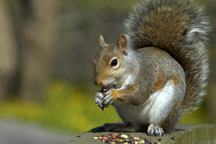Squirrels
 Squirrels are small rodents and they vary in size, ranging from 6-12 inches in body length. St. Louis has a lot of squirrels and, for the most part, they add an element of charm to the many parks in our city. Sometimes, however, they nest in the attics or tight spots of our homes and businesses, where they quickly become a problem.
Squirrels are small rodents and they vary in size, ranging from 6-12 inches in body length. St. Louis has a lot of squirrels and, for the most part, they add an element of charm to the many parks in our city. Sometimes, however, they nest in the attics or tight spots of our homes and businesses, where they quickly become a problem.
When they get into your house, it’s usually to set up a nest. They generally gain access to homes and businesses by way of tree limbs in need of trimming, making their way in through vents or chimneys. Squirrels often nest in shaded areas, like attics, which offer readily available nesting material, plenty of space to raise a litter and food, sometimes scavenged from your own shelves. They can make a lot of noise, and they definitely leave droppings and urine behind.
As you can see, the activities squirrels engage in to build their nests can be an enormous nuisance. More importantly, nesting activities can cause significant structural damage to your home or business, such as shredded roofs, wall paper and insulation, as well as chewed electrical wires, which can present a fire risk.
The most common species of squirrel in the area is the Grey Squirrel. They can live as long as 12.5 years, and produce a litter of two to six young twice a year. Clearly, a squirrel problem is a long-lived situation that expands exponentially. Consequently, waiting for the squirrels that have taken up residence in your home or business to evacuate the nest, once their litter has been raised, is not a viable pest-control solution. Bearing in mind the type of damage squirrels are capable of, neither is simply boarding up an area of access.
Our Approach:
Trapping any wildlife is not for the do-it-yourselfer. Under all conditions, it requires an understanding of animal behavior, knowledge that can only be attained through experience. This is why a Cogent technician should be considered.
We practice humane catch and release for all wildlife, including squirrels. Depending on the condition, we trap in a variety of different areas, including ground, gutter, roof, soffit, and attic.
A free inspection is typically required before we submit a quote. We do this in order to determine what is, or is not, necessary to effectively deal with your squirrel problem. Our upfront pricing and “unlimited catch” policy go hand in hand to prevent surprise costs at the end of the job.
